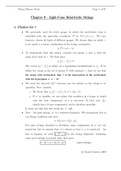Summary
Summary String Theory for Undergraduates (8.251)_2 - 2009 Lecture Notes
- Course
- Institution
Work at MIT String Theory for Undergraduates (8.251): miscellaneous partial notes (1, 2, 3) taken during the class, unlikely to be anywhere near as good as the course book by Prof Barton Zweibach who taught it.
[Show more]



